How To Root Dracaena Plants. Root Snake Plants & More
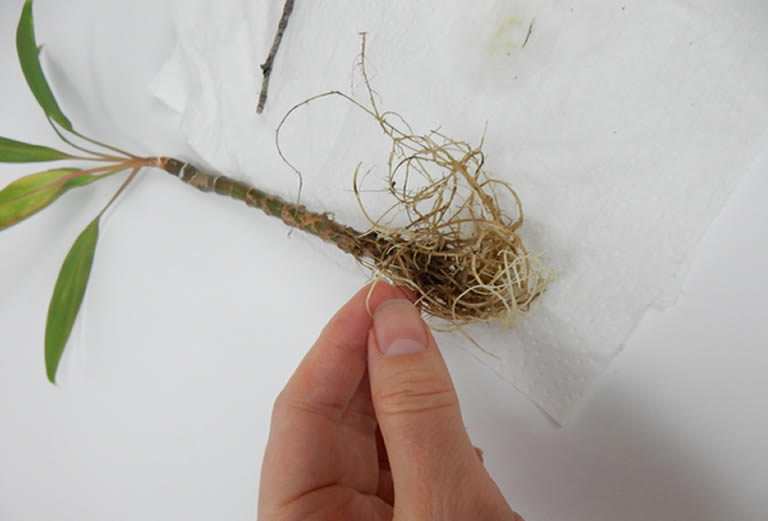
Dracaena is an extremely popular houseplant due to its lush foliage and easy-care nature. Snake plant and dragon tree are 2 of the most popular dracaena plants. Rooting a dracaena cutting in order to propagate a new plant is a great way to grow new dracaenas. In this article I outline how to propagate new dracaena plants.
Below I walk you through the entire process, from taking a cutting from an existing plant to cultivating a new plant. The information provided below also includes essential tips for rooting dracaena cuttings in either water or soil.
Table of Contents
How To Propagate & Root Dracaena
Dracaena is a tropical succulent consisting of about 120 different species of trees and shrubs that grow natively in Africa, Southern Asia and the northern regions of Australia.
As an easy-care succulent dracaena owners often want to know how to propagate and grow new plants from their existing dracaena plant. Propagation is also a great way to continue the life of a dying dracaena. This is a very straightforward and easy process as I will outline below.
You must bear in mind though that dracaena, as I pointed out in the article how do you regrow dracaena leaves, is a slow grower and it can take up to 10 years before your newly propagated plant is fully mature.
Before I give you the exact steps necessary to cut, root and grow dracaena I will cover a question that I am often asked regarding the timing of propagation.
A word of caution: dracaena is poisonous to some pets (this includes the dracaena dragon tree) and you may want to ensure your pets are safe around this plant before deciding to cultivate it. Read our article is dracaena poisonous for more information.
The best time to propagate dracaena indoors and outdoors
Many dracaena owners wonder if there is a specific time that is best for propagating dracaena. When can you propagate dracaena?
You can propagate dracaena at any time of the year if growing the succulent as a houseplant. For outdoor dracaena it is best to begin the propagation process at the beginning of the plant’s natural growth cycle, in the early spring.
Because of modern climate control systems like HVAC, normal household temperatures fall into the ideal range for dracaena pretty much all-year-round.
Dracaena grow best in temperatures between 65°F – 75°F. With an average consistent household temperature of around 70°F this means dracaena makes a great houseplant.
So, with such consistent temperatures being maintained in the average home throughout the year, this mean dracaena can be propagated at any time of year as an indoor plant.
Just ensure the plant is kept away from temperature fluctuations and any extreme heat or extreme cold blasts that may occur from outside-opening doors.
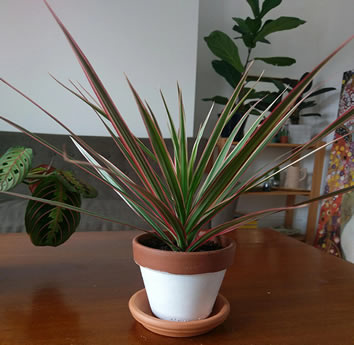
Only those readers who live in USDA climate zones 10 – 11 should grow dracaena outside as other parts of the country do not have the type of climate suitable for this tropical succulent.
If you live in a suitable area and are set on propagating dracaena outside you should plant new cuttings in early spring to give them the best chance of rooting.
How to propagate dracaena the right way
Before we now look at the key steps you must take to propagate a new dracaena from an existing plant I want to address a very common question that is posed to me about existing dracaena plants.
How to multiply dracaena
I have found that when I am asked how to multiply a plant the questioner is usually referring to expanding an existing plant in its pot.
To multiply dracaena you must propagate one or more new plants from the cuttings of an existing plant. By rooting cuttings in either water or soil you can multiple the number of dracaena plants you have.
Although separate plants they can be grown in the same pot giving the illusion of a bigger plant.
Before I cover how to root new cuttings in order to grow entirely new plants, it is important you know how to take a cutting. You see, when you cut a stem correctly you give the new cutting a much better chance of rooting.
When cut incorrectly you drastically reduce the chances of a cutting developing roots and thus reduce the chances of growing a new plant.
So, the first step in dracaena propagation involves taking a cutting from a healthy dracaena plant, though of course you can source cuttings from a nursery or online store.
You can cut the top off your dracaena and replant it for propagation
Many houseplant owners that are new to propagation are unsure of exactly how to take a cutting. Many wonder if they can propagate new plants from the cuttings taken after they have pruned their existing dracaena.
You can cut the top off your dracaena plant and replant that in order to cultivate a new plant, as each each section of stem has the capacity for developing roots from its base. Cutting the top of the plant will also make the plant look bushier.
Although it is best to take a longer cutting than a shorter one, any cutting has the potential to grow into a new plant.
So, cutting the top of your dracaena is a great way to get a cutting for cultivating a new plant and I will often cultivate new plants from cuttings after I have pruned a dracaena.
How to cut the stem of a dracaena for propagation
Although dracaena have a main stem that acts as the trunk of the plant, a dracaena plant will often grow additional stems to the side of this main stem. They can often look unsightly and take away from the pleasing look of the plant.
Many dracaena owners are unsure if it will be harmful to the plant to removes these offshoots. It is perfectly fine to remove offshoots from your dracaena as it will do no harm to the plant and many times will make the plant look better.
But, what about cutting the main stem … is that possible?
You can cut the stem of a dracaena for both pruning purposes and to propagate a new plant. It is not advisable to cut the main stem of the plant too close to its base as dracaena is a slow grower and it will take time for the plant to grow back to its normal size.
Cutting the top 1/4 of the stem is preferred though you can cut as much as 3/4. You can also cut offshoot stems growing to the side of the main stem, at their base and use them to cultivate new plants.
Using an entire offshoot stem, or the top of the main stem, as a cutting for growing a new plant is one of the best ways to propagate new dracaena.
So don’t be afraid to remove an entire offshoot for use in propagation, or even prune the top of the plant by a few inches, as it will not harm the plant.
How to take a dracaena cutting for propagation
The best way to take a dracaena cutting is to cut at a diagonal angle into the stem, either cutting an offshoot stem at its base or the main stem at the top.
By cutting at a slight angle you will give the cutting a better chance of rooting.
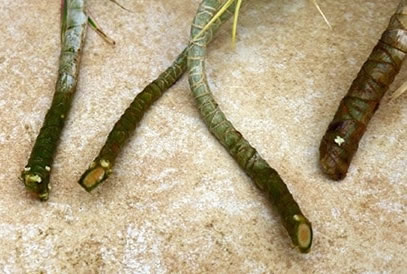
If you take a larger section of stem it is possible to subdivide it into several sections as each section has the potential to grow into a new plant.
Just be sure to keep a note of which end is the lower part of the stem, after you subdivide your initial cutting, as this is the end where the roots will develop.
How to root dracaena
Now that you know how to take a cutting we will look at how to root it.
It is the rooting process that is the most important aspect of propagation.
Once a new cutting has developed roots cultivating a new plant is just as easy as caring for an existing one. So, it is important for you to give the most amount of attention to rooting dracaena cuttings during the entire propagation process.
How to root dracaena in soil
Planting a dracaena cutting in a pot is a straightforward process. The most important thing to consider when potting a dracaena cutting is the soil you use.
You must use a very specific type of soil for dracaena plants. Regular potting soil alone is not sufficient for this succulent and, as surprising as it may sound, succulent soil is just as bad!
As a succulent dracaena requires soil that is fast-draining but the sand content in most succulent soils will choke the roots of oxygen and so a slightly altered version of a typical succulent soil is required.
Just like other succulents, dracaena needs a soil that is a mixture of nutrient-rich compost and a substance that allows for fast water-drainage, like perlite or vermiculite. But because dracaena needs good airflow to its roots an additional material must be added to the soil mix and the usual sand content of succulent soil must be omitted completely.
In most cases pumice is used to help create good airflow in the soil though oak bark is also popular.
The ideal soil mix for for propagating dracaena:
- 1/2 compost or houseplant potting mix.
- 1/4 perlite or vermiculite.
- 1/4 pumice or cut oak bark (or similar).
This soil mix recipe can be used throughout the life of the plant.
If you choose to plant your dracaena cutting directly into soil then it is best to first dip the cut end of the cutting into a hormone powder, and then directly afterwards, dip it into a rooting gel.
This will give the cutting the best chance for developing new roots. I have found this little trick dramatically increases success rates with rooting in all plants.
Ensure you keep the pot that contains the cutting in warm location that gets good strong indirect light (see our dracaena light requirements article). If the area in which you place the cutting is very dim consider using a grow light to give the plant a daily dose of artificial light for 4 hours.
Ensure the cutting is not getting any artificial light during the night as it also requires darkness.
Be very careful with the watering routine of the dracaena cutting especially at this early stage when roots have not yet developed – this also applies to fully grown plants as incorrect watering can lead to a host of problems that usually start with drooping leaves and end with an expired plant.
As you can see rooting a dracaena in a pot is an easy process but it isn’t always successful. There is a much better way that has a much higher chance of success. Although you can root dracaena in soil it is actually better to root the cutting in water before planting it in a pot.
By first using water to root dracaena, before planting the cutting, your propagation success rate will greatly improve and you should see a 90% success rate. Though, I would try to root at least 2 cuttings just to make sure you get at least one plant from your efforts.
How to root dracaena in water
Many plant species can be rooted in water but with succulents being so susceptible to root rot and other water-related problems dracaena owners are often hesitant to attempt rooting in anything but soil. This hesitancy is unfounded.
It is possible to root dracaena in water. In fact, this is the best way to root a dracaena cutting.
However, once the the roots have grown 1″ long the cutting should be removed from the water and potted in moist soil. Do not leave a cutting in the water when it has roots longer than 2″ or the new plant will drown.
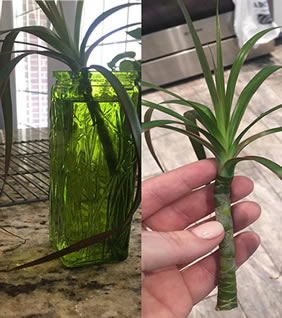
You can use standard tap water poured into a jar to root the cutting. Place the cutting, cut end first, into the water ensuring that the entire cutting is not submerged (see image above).
Some plant cultivators will only use distilled water as there is evidence to suggest plants grow better in distilled water. Tap water, at least in the US, contains both fluoride and sodium that are not beneficial to plants.
However, if I have no distilled water at hand I will happily use tap water for rooting dracaena (and any other plant).
Whatever water I am using I will add to it a little secret sauce: in with the water I add a few drops of good quality floral feed, like this one. Although floral feed is designed to sustain and prolong the life of cut vase flowers it will give your cutting a much-needed nutrient boost and help it to develop roots.
Change the water every 5 days being sure to remember to add a few drops of floral feed.
Once rooted your dracaena cutting should be potted in the appropriate type of soil (see section above). The roots should be at least 1″ in length before you pot the new plant.
This is not an exact science so there is no need to get out the measuring tape. 😉 But, allowing the cutting to form long roots will give it the best chance of developing into a mature dracaena once potted.
A word of caution: don’t let the roots get too long before potting the cutting. A maximum of 2″ is more than enough.
Before you pot the rooted cutting make sure the soil is moist but not soaked. See our lemon lime dracaena watering guide and the article about dracaena not growing for more information. The container/pot must also have at least one drainage hole.
Although you can tent the newly rooted cutting to help maintain high humidity levels, and to protect the newly growing plant, it is not strictly necessary. As long as you give the newly potted cutting the same care and attention you give your adult dracaenas the plant will thrive. This may mean investing 20 bucks or so in a good plant humidifier.
Be aware that dracaena are slow growers. This means you could be waiting up to 10 years before you have a fully mature dracaena, depending on the species you are cultivating.
How to propagate a lemon lime dracaena
The propagations for lemon lime dracaena is the same as for any other dracaena species. I only mentioned here because it is such a popular dracaena houseplant that I am often asked about propagating it specifically.
You should review the information above and follow the guidance given if you want to propagate lemon lime dracaena.
Once you have rooted a new lemon lime dracaena you will want to follow the advice in the article how to make lemon lime dracaena bushier to ensure the new plant grows out as well as up.
How to propagate dracaena warneckii
Although less common or popular than a lemon lime dracaena, the dracaena warneckii is also grown as a houseplant and I am often asked about the best propagation process for it.
The propagations for dracaena warneckii is the same as for all other dracaena species. Review the information in this article and follow the guidance given for propagating dracaena warneckii, starting with a simple cutting.
How long dracaena normally takes to root
So how long will you have to wait before your new cutting grows roots?
It can take several weeks, or even months, for a dracaena cutting to develop roots when potted in soil. Propagating dracaena cuttings in water will produce roots much faster.
You should start to see signs of some new root growth within 10 days when propagating dracaena in water.
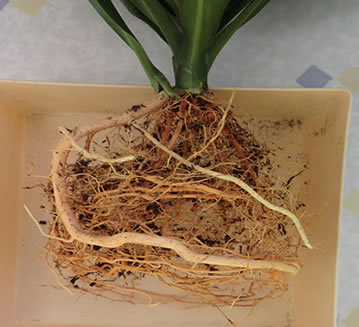
Although dracaena are slow growers a cutting should start to form new roots fairly quickly when it is propagated in water. Apart from it being a faster way of rooting dracaena, it is also the best way to tell if your cutting is actually forming into a new plant.
Without digging up a cutting you have no way of knowing how well, or not so well, it is developing roots when you are using soil for propagating dracaena. Whereas in a water filled jar you can instantly see the progress of your cuttings.
It is usual to see at least some root growth on a cutting that is placed in water after about 10 days. Water propagation is much faster as far as root development goes than soil propagation.
If there is no root growth on a cutting after several weeks you may need to begin again with a fresh cutting and the cutting will likely look wilted anyway. If you use my floral feed trick as outlined above then this is unlikely to happen.
Thanks for reading! I'm Michael — houseplant fanatic and your Pinterest plant guide.
Follow me on Pinterest for fresh updates 🌿



